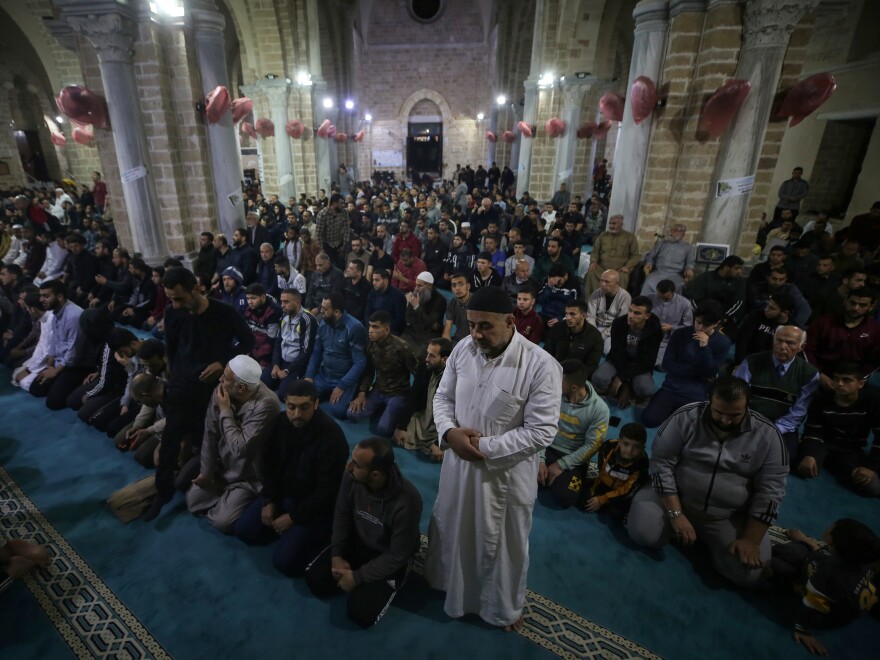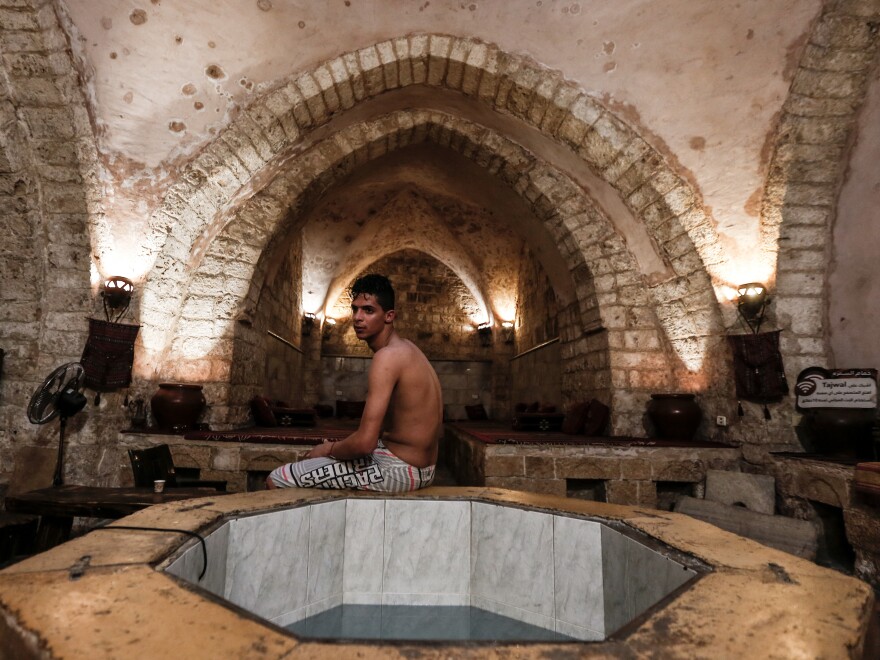The stately palace where Napoleon is said to have slept for a few nights. The last remaining Turkish bath, offering full body oil scrubs. The antiques shop with its trove of dusty treasures for sale.
So many of Gaza City's gems are no more.
They withstood decades of upheaval, preserving the memory of Gaza's ancient glory as a crossroads of civilizations. Now they have now been decimated in Israel's ongoing bombardment of Gaza, the deadliest war Palestinians have ever faced, prompted by the deadliest day Israelis have ever endured, when Hamas attacked Oct 7.
"It's really heartbreaking to see all this, and to think about the city that I cherish, that I'm from, that I love, in complete ruins," says Palestinian-American author Laila El-Haddad, fighting off tears. Her parents grew up in Gaza and she used to live there. "I just can't imagine why — what the point is of destroying all these places."
The destruction of Gaza's cultural heritage sites is among the crimes South Africa has alleged in its genocide case against Israel.
We asked the Israeli military, the IDF, why it targeted these sites. It said some contained militants and tunnels.
"In response to Hamas' barbaric attacks, the IDF is operating to dismantle Hamas military and administrative capabilities," it said. It blamed "the malicious exploitation by Hamas of civilian buildings, including significant, mainly religious sites, for its own terrorist purposes."
The Israeli military did not announce the targeting of these historical heritage sites. But Israeli media has reported the demolition of contemporary statues and monuments associated with Hamas.

So much has been lost in Gaza, beyond the catastrophic death toll. More than half of Gaza's buildings are estimated to have been destroyed.
But these landmarks showed another face of Gaza, different from the den of misery the world has come to know. For Palestinians, these sites were part of the tangle of threads linking their daily lives to their heritage stretching back thousands of years — an intangible connection to the past that cannot be replaced.
We toured some of those sites ourselves in 2019, and created this mini travel guide to Gaza City, documenting the historical and cultural landmarks that tourists used to visit, before Hamas took control in 2007, and an Israeli blockade, supported by Egypt, sealed Gaza off from most outside visitors.
After nearly four months of war, every site we visited then is now destroyed, badly damaged, or inaccessible.
We could not survey this ourselves. Journalists cannot enter Gaza during the war. So NPR asked Omar El Qattaa, one of the few remaining photojournalists in Gaza City during these months of war, to document the destruction, so we could compare NPR's photos of what existed before this war began to what remains now.
Loading...
We shared the images with Ayman Hassouna, an historian of archaeology who had taken us on a tour of these sites in 2019. He fled his home in Gaza City when the current war began.
"I am shocked by the photos," says Hassouna. "I cannot believe what has happened. It's like a nightmare."
Few Gazans have been able to see what has happened to the sites since the war began. Most living in Gaza City escaped to the south in the early weeks of the war. As Israeli troops withdrew from parts of Gaza City in recent weeks, residents who did not flee the city ventured outside to make sense of their new, shattered landscapes.
Omari Mosque, Gaza's most iconic historical site
The Omari Mosque was the oldest mosque in Gaza, dating back to Crusader times. Destroyed by earthquakes and conquests, and rebuilt many times over history, the mosque had a storied history.


It was originally a 5th century Byzantine church that was built over a more ancient temple. It was converted into a mosque in the 7th century, then a Crusader church in the 11th century, and back to a mosque in the 13th century. The architectural elements of the Crusader church were still apparent in the modern-day mosque, and an etching of a Jewish menorah on a mosque column, believed to have been originally part of an ancient synagogue, was once documented, and was destroyed in recent decades.
Now Gaza's central mosque, with its blue-carpeted floors and stained glass windows, is unrecognizable.
The Israeli military told NPR it struck the Omari Mosque to target militants and a tunnel shaft within the building.
The Samaritan Hammam bath
The Samaritan Hammam, a traditional domed bathhouse restored in the year 1320, was originally run by members of the ancient Samaritan religion. All that remains of the Samaritan Hammam are some archways nearly buried in the building's rubble, and the sign that used to be posted outside.


Ahmad Elyassi, 38, stood next to the ruins of the bathhouse where he used to bathe with friends. Pinpricks of light used to stream through colorful holes in the domed ceiling. Bath attendants would give full body oil scrubs.
"I am honestly stunned," he says. "I didn't expect they'd destroy it and level it."
The Israeli military said it struck the Samaritan Hammam with "precision munitions" to target a Hamas squad and a network of tunnels inside.
The military said it could not find information about the other landmarks on our list.
Pasha's Palace, where Napoleon is said to have stayed
The Pasha's Palace was built by a Mamluk sultan in the 13th century. A second story was added several hundred years ago during the Ottoman era. It is where Gaza historians say Napoleon spent three nights in February of 1799 during his military campaign in the region.
In contemporary Gaza, it was a museum displaying Gaza's archaeological treasures, including centuries-old ceramic jars that had carried wine and olive oil from Gaza to ports across the Mediterranean — a reminder of a time of peace and economic prosperity for Gaza, and of its seafaring heritage.


Now, Pasha's Palace is mostly rubble. Some outer walls and intricate archways remain standing. The current fate of the antiquities it displayed is unknown. The only item visible now is a destroyed car on a mound of dirt in front of the ruined palace.
Antiques shop, packed with treasures


The Old Town Antique Store, a stall along a once-bustling marketplace, once brimmed with old photo albums, brass hamsa pendants meant to ward off the evil eye, and rare English books.
Among the collection that once stuffed the shop: an original 1924 copy of "Crime and Criminals in Palestine" by a Jerusalem police inspector, and a 1930s telephone book featuring prominent Jewish and Palestinian families who were since scattered into exile and diaspora.
Now the antique shop has been destroyed. Old film negatives are scattered among the debris. Saleem Elrayes, the cheery English-speaking owner who ran the shop for more than 30 years, could not be reached.
Gaza's revered fish restaurant
Gaza's beachside fish restaurant, Al Salam Abu Haseira, is where we sat in 2019 at a long table, dining on grilled fish seasoned with hot pepper, parsley, onions, lemon and tomato. Its specialties were a touchstone of Gaza's seafaring tradition, including shrimp zibdiyeh, a spicy tomato stew, served in Gaza's traditional clay zibdiyeh cooking pots.
The restaurant is now damaged, as seen through its wide windows facing the Mediterranean Sea.


A cafe in an old mansion
Beit Sitti, a chic cafe-restaurant nestled in a three-story traditional mansion, and an ode to Palestinian cultural heritage, is still standing, according to its previous owner, Gaza playwright and caricaturist Atef Salama. But it is locked and inaccessible, he says, and those who have keys have fled Gaza City and are unable to return.


Set around an airy courtyard with caged birds and plants climbing the walls, the cafe served a traditional Palestinian breakfast spread of jams and mini flatbreads topped with cheese and za'atar spices. On Thursday evenings, it hosted a young clientele for dinner, water pipes and live Arabic music.
A hotel and museum


Al-Mathaf, which means "The Museum," is a 36-room room boutique hotel with sea views. It had a resplendent reception area with a patchwork of tiles and stones salvaged from old Gazan homes. The owner's private collection of Gazan antiquities had been displayed in the foyer.
What happened to the hotel was unclear until early February, when Israeli troops had already withdrawn and it was safe for residents to approach the area.
Our photographer found the hotel severely damaged. The reception hall was littered with shattered stones and tiles. Ancient jugs were smashed. Windows were broken, walls were pockmarked and roofs were demolished. The manicured garden of palm trees and cacti outside was ravaged. An exterior wall displayed Hebrew graffiti; one soldier had sprayed a message to his brother, a Hamas captive. The hotel appears to have been set on fire.
We sent photos to Jawdat Khoudary, the hotel owner who left for Egypt.
"I am crying blood from a broken heart," he texted back. "A house can be rebuilt, a son can be born, but when history is erased, it is difficult to restore."
Copyright 2024 NPR




